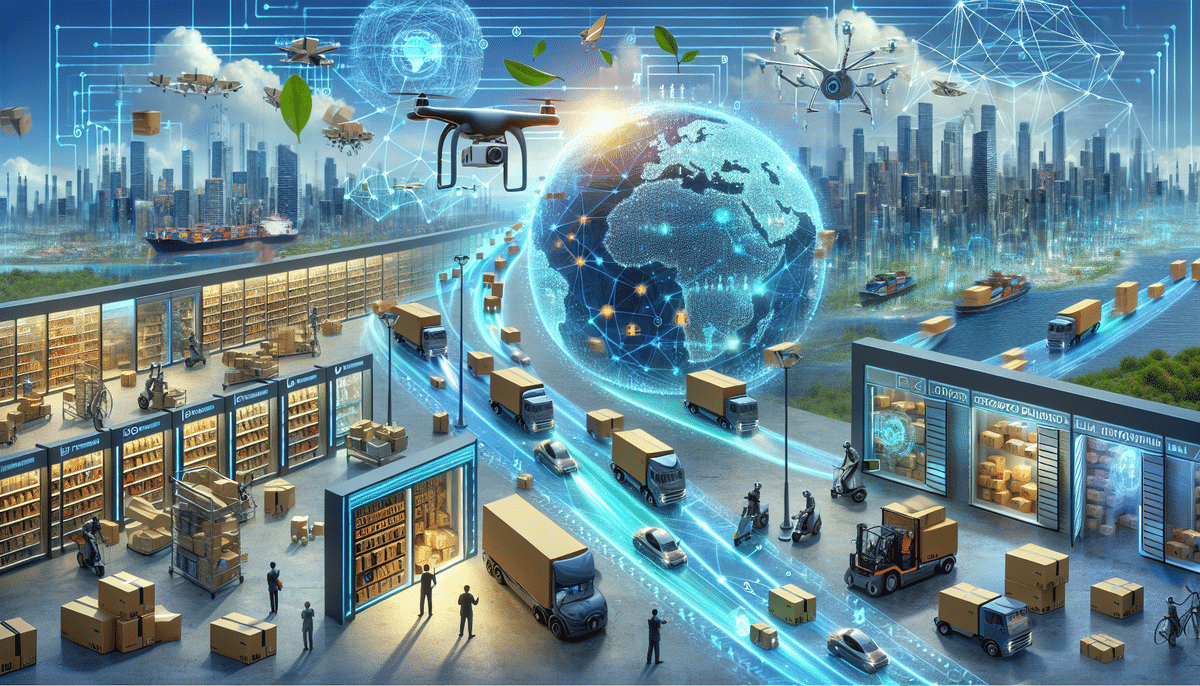7 Shipping Trends to Watch in 2024: What to Expect in the Coming Year
As we advance into 2024, the shipping industry continues to undergo rapid transformation, driven by the persistent rise of e-commerce, cutting-edge technological advancements, and evolving customer expectations. In this article, we'll explore seven key shipping trends to watch in the coming year and how they will shape the industry. So, what can you anticipate in the world of shipping in 2024?
Introduction: The Importance of Keeping Up with Shipping Trends
Staying ahead of shipping trends is crucial for businesses aiming to maintain a competitive edge. With fast-changing customer demands, intense market competition, and continual technological innovations, the shipping landscape is in constant flux. Embracing the latest trends and technologies is essential for businesses to thrive in this dynamic environment.
One of the emerging trends in shipping is the deployment of drones for delivery. Although still in its developmental stages, numerous companies are exploring drone technology to enhance delivery speed and efficiency. This innovation has the potential to revolutionize the shipping industry but also introduces new challenges and regulatory considerations. Keeping abreast of these developments and integrating them into your shipping strategy is vital for staying competitive.
Trend #1: The Rise of E-Commerce and Its Impact on Shipping
The continued rise of e-commerce remains the primary driver of change in the shipping industry. With an increasing number of consumers shopping online, the demand for fast and reliable shipping options continues to grow. Businesses that fail to meet these expectations risk losing customers to more efficient competitors.
To keep pace with this trend, many companies are investing in advanced technologies such as automated warehouses, drones, and robotics to accelerate order fulfillment and enhance operational efficiency. According to Statista, global e-commerce sales are projected to reach $6.3 trillion by 2024, underscoring the significant impact on shipping logistics.
Additionally, the surge in e-commerce has amplified the demand for sustainable shipping practices. Environmentally conscious consumers are increasingly favoring businesses that prioritize sustainability in their shipping methods. This has led to innovations like electric and hybrid delivery vehicles and the adoption of biodegradable packaging materials. Emphasizing sustainable shipping not only attracts eco-minded consumers but also contributes to environmental preservation.
Trend #2: Increased Use of Automation and Robotics in Shipping Operations
Automation and robotics are fundamentally transforming the shipping industry. Technologies such as autonomous vehicles, drones, and warehouse robots are becoming integral to shipping operations. These advancements are particularly beneficial for tasks that require repetitive actions, such as loading and unloading cargo.
By automating these processes, businesses can significantly improve efficiency, reduce operational costs, and minimize the risk of workplace accidents and injuries. Moreover, the integration of automation and robotics has spurred the creation of new job opportunities within the industry. There is a growing demand for skilled professionals in robotics, engineering, and computer programming to develop, operate, and maintain these advanced systems.
According to a report by the International Federation of Robotics, the use of robotics in logistics is expected to grow by 20% annually, highlighting the increasing reliance on these technologies in the shipping sector.
Trend #3: Sustainability and Green Initiatives in the Shipping Industry
Environmental sustainability is becoming a critical focus for the shipping industry. Businesses are under mounting pressure to reduce their carbon footprint and implement green initiatives. Key strategies include the use of biofuels, electric vehicles, and optimized routing to decrease emissions.
Innovative solutions are being developed to minimize waste and enhance recycling processes. Companies are also exploring alternative packaging materials, such as biodegradable and compostable options, to reduce environmental impact. Partnering with environmental organizations further supports conservation efforts and promotes sustainable practices within the industry.
According to the International Maritime Organization, the shipping industry aims to reduce greenhouse gas emissions by at least 50% by 2050 compared to 2008 levels, emphasizing the sector's commitment to sustainability.
Trend #4: The Emergence of Blockchain Technology in Supply Chain Management
Blockchain technology is set to revolutionize supply chain management by enhancing transparency and security. With blockchain, businesses can track the movement of goods from origin to destination, reducing fraud risks and improving accountability.
This technology is especially valuable in complex global supply chains where tracking and verification pose significant challenges. Blockchain streamlines supply chain processes by minimizing the need for intermediaries and reducing paperwork, resulting in faster and more cost-effective transactions.
Furthermore, blockchain fosters greater collaboration and trust among supply chain partners, as all parties have access to the same verified information. However, the adoption of blockchain in supply chain management is still in its nascent stages, facing challenges such as standardization, interoperability, and scalability.
Despite these hurdles, the potential benefits of blockchain in supply chain management are substantial, with experts predicting widespread adoption in the coming years. For more insights, refer to the latest blockchain studies.
Trend #5: The Growing Demand for Last-Mile Delivery Solutions
Last-mile delivery is an increasingly critical component of the shipping process, driven by customer expectations for faster and more convenient shipping options. To meet this demand, businesses are adopting innovative delivery models such as locker systems, drone delivery, and optimized routing.
- Locker Systems: Provide secure and convenient pickup locations for customers.
- Drone Delivery: Enables quick and efficient delivery, especially in urban areas.
- Optimized Routing: Enhances delivery efficiency and reduces operational costs.
The COVID-19 pandemic has further accelerated the need for last-mile delivery solutions, as more consumers turn to online shopping and seek contactless delivery options. According to a PwC report, same-day delivery service requests have increased by 35% since the onset of the pandemic.
To stay competitive, businesses are investing in the necessary technology and infrastructure to enhance their last-mile delivery capabilities.
Trend #6: Advances in Artificial Intelligence for Optimizing Shipping Routes and Delivery Times
The integration of artificial intelligence (AI) is driving significant advancements in the shipping industry, particularly in the optimization of shipping routes and delivery times. AI algorithms analyze vast amounts of data to identify the most efficient routes, reducing both costs and delivery times.
One of the primary advantages of AI in shipping is its ability to adapt to real-time changes. For instance, if there is unexpected traffic congestion or a shipment delay, AI can quickly recalibrate the best alternative routes and adjust delivery schedules accordingly. This flexibility ensures minimal disruption to the supply chain.
Additionally, AI can process data from various sources, including weather forecasts and traffic patterns, to make more informed predictions and recommendations. As AI technology continues to evolve, even more sophisticated solutions for optimizing shipping and logistics operations are expected to emerge.
According to a study by McKinsey & Company, AI-driven logistics solutions can potentially reduce shipping costs by up to 15% and improve delivery speed by 20%.
Trend #7: The Impact of Changing Trade Policies on Global Shipping Networks
Global shipping is significantly influenced by evolving trade policies, especially those related to tariffs and trade agreements. Businesses operating on an international scale must stay informed about these changes to remain competitive and compliant with regulations.
Trade policy shifts can lead to substantial disruptions in supply chains, including port closures and workforce shortages. For example, the ongoing trade tensions between major economies, such as the United States and China, have led to increased tariffs on goods, affecting shipping companies reliant on these trade routes.
Moreover, the growing emphasis on sustainability and reducing carbon emissions is shaping global shipping networks. The development of new technologies and alternative fuels, such as electric and hydrogen-powered ships, is altering shipping routes and operational practices.
Staying informed about trade policy changes and adapting shipping strategies accordingly is essential for businesses to navigate the complexities of global shipping. For the latest updates, refer to the U.S. Department of Commerce Trade Policy page.
Conclusion: Preparing Your Business for the Future of Shipping
The shipping industry is in the midst of rapid transformation, and businesses that fail to adapt risk falling behind their competitors. By embracing the latest trends and technologies, companies can enhance efficiency, reduce costs, and meet evolving customer expectations.
Key strategies include:
- Investing in Automation and Robotics: Streamline operations and improve accuracy.
- Implementing Green Initiatives: Adopt sustainable practices to appeal to eco-conscious consumers.
- Enhancing Last-Mile Delivery: Utilize innovative delivery models to meet customer demands.
- Leveraging AI for Optimization: Use artificial intelligence to refine shipping routes and delivery schedules.
One of the most pivotal trends is the dominance of e-commerce, necessitating the ability to handle large volumes of small packages and ensure swift, reliable delivery. Technologies such as drones and autonomous vehicles are instrumental in meeting these demands.
Sustainability remains a cornerstone of future shipping practices. Consumers are increasingly aware of the environmental impact of shipping, and businesses that demonstrate a commitment to sustainability are more likely to succeed. This commitment can encompass the use of eco-friendly packaging materials, optimizing delivery routes to reduce emissions, and investing in alternative fuels.
By proactively preparing for these trends, businesses can position themselves for success in the future of shipping.






















